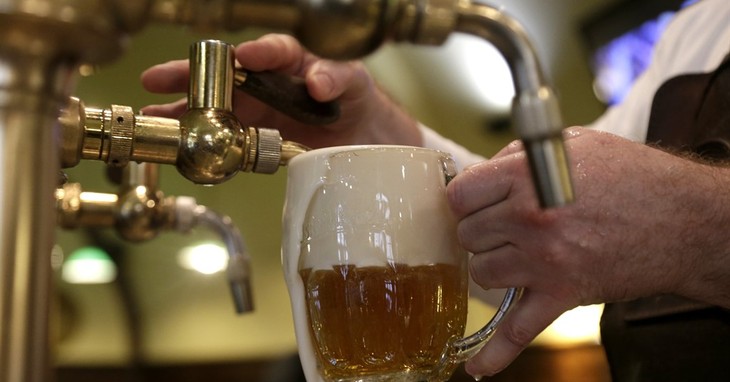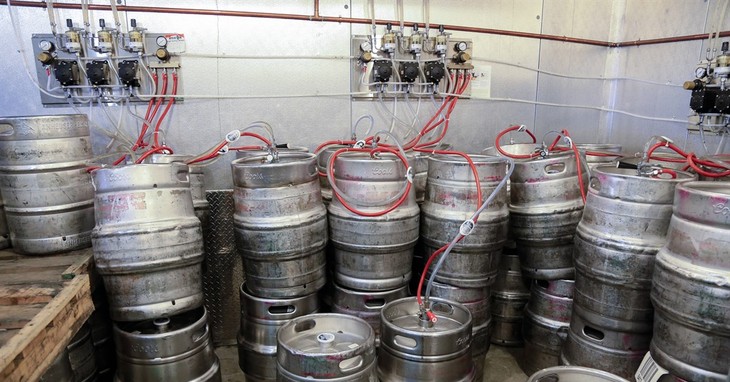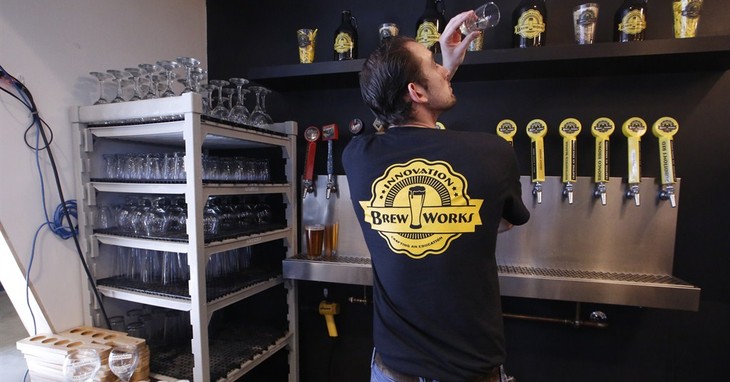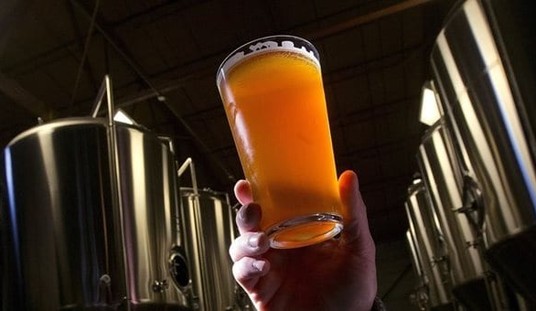Draft Beer can be a better selection, but not always.
You can go to many bars and see people sitting side by side, drinking the same beer, but in a different fashion. One might be pulling from a longneck, while his stoolmate is sipping a pint of unmarked suds, yet while they are both sampling from the same label, the experience can be vastly different. The draft beer option is usually the closest approximation to the brewer’s intent, so whenever given the choice, Draft is usually the better option.
While most are familiar with the rather pedestrian task of pulling a handle to fill a glass, getting those contents to you in order to engage in foam-sucking is an involved task. It begins, obviously, at the brewery, where the finished product is not sent to the cannery or bottling floor. Instead a tavern head attachment feeds the new beer directly into kegs, readying them for transport.
The metal kegs sent to bars and restaurants contain 15.5 gallons of product, called half-barrels as that official measurement, from the days of yore, was set that 31 gallons made up a traditional barrel. When space is a factor, bars might opt for a pony keg (a quarter-barrel) or the sixtel keg (a ⅙ barrel, also referred to as a ‘slim’). An empty half-barrel keg is 30 pounds, with approximately 130 pounds of beer, when filled.
Some proprietors will measure their keg contents by weight to figure how many servings remain. A pound of beer comes in roughly at 15.2 ounces, so they might gauge contents using a mostly simple formula: Total Keg weight – 30 = Pounds of Beer Remaining X 15.2 fl. oz. = Total fl. oz. Left in Keg. Prices can be calculated once you know a filled half-barrel has 165 12-ounce servings or 124 16-ounce pints in a full keg.

The differences between the bottled and keg versions are many, but the primary one is that kegs are filled directly from the finishing vats and are never pasteurized. This means they are given an expiration date that is roughly half that afforded the bottled product. By design, draft is fresher tasting and a more pure version of a label, but it also means it is more sensitive, and care needs to be taken to keep that quality in place. Here is where the problems could arise.
The Delicate Balance to Get Tipsy
From the time the kegs are filled, they need to remain in a cold state. Shipping, warehousing, delivery, storage, and serving must all be done within proper cold environments. Many breweries have a direct uplink to the thermostats in the cold storage warehouses of their distributors, so if the temperatures rise, they receive a call to determine the issue behind the rise in temperature. Sometimes during heavy delivery times, the insulated doors may be opened too frequently, leading to the rise, provoking a call. This is how serious they take the preservation of the kegs.
Just as important in the process of getting draft into your glass is the serving process. Draft pouring systems in establishments can be a delicate science, depending on the conditions on-site. There are two primary methods for this delivery; short draw or long-line systems. The short draw is a self-contained unit, consisting of a doored cooler behind the bar for kegs, with a tower on top for pouring the selections. These are the most reliable draft methods, but space is a consideration, and if you have a small work area or desire to have a wider selection of brands, then a longline system is needed.

Now you are employing a walk-in cooler a fair distance from the serving area, so you need to construct your delivery system. From the cooler, you need to run your beer tubing, your cooling tubing, and an insulated wrap, all of which comprise your trunk line. For delivery from the walk-in, you need to propel the beer with CO2, in a calibrated pressure based on the distance and elevation of your run. Each beer will have its own CO2 regulator. A wall-mounted device referred to as a Foam On Beer Detector serves as a check system for when a keg runs out. The purpose is that, instead of filling your long lines with gas and leading to a lengthy and wasteful period of purging the foamy result, the detector will first empty and a ball — previously floating — will drop and cut off the flow.
Along your beer lines is the cooling system. Usually atop the beer cooler is the power pack, which is a circulating system of propylene glycol feeding into tubing that runs parallel to the beer lines. Depending on how many brands you serve, this will factor on your amount of propylene lines as well, since your beer needs to remain in contact with the cooling tubing within the trunk line.
One last detail that has to be regularly addressed is a schedule of cleanings to be performed on the draft system. The breweries should have technicians sent at regular intervals to flush and clean the beer lines with strong alkaline products. The reason is the lack of pasteurization means the yeast remains active, and if it settles on sediment or exposed areas, then it can reactivate and deliver an unpleasant taste to the beer. If you have ever had the experience of an unfresh or “skunky” beer on tap, this is likely due to this yeast problem.
Foam Here to Beer Clarity
Do not be afraid to send the beer back and let the bartenders and/or manager know. They are eager to fix a problem that is leading to diminished sales. The maintenance involves the caustic cleanser that flushes the lines of impurities, which also is used on the hardware after it is broken down, and then cleaned.
The one time to be cautious of draft beer is in very large venues. Stadiums and casinos, as examples, are notorious for having a poor-tasting draft beer as a result of their resistance to this cleaning process. Frequently, these locations have beer coolers a considerable distance from the bar. My preferred hockey club has a beer cooler servicing multi-levels of the arena, some hundreds of feet in distance, and one casino I know has a beer cooler 400 yards from the service area.

The draining of the lines for a cleaning can involve dumping out a significant amount of beer, an expense they are loath to absorb. The result is infrequent cleanings and the rise of problems.
Other issues may arise requiring technician assistance, usually in the form of foaming. The beer-pouring in this way can be a result of dirty equipment, a pressurization issue, or, most commonly, temperature. Depending on the beer type, a temperature of just 45 degrees could lead to a foamy pour, as the increase in temperature will lead to the CO2 bubbles expanding.
While much of this sounds like headaches for proprietors, there is sound reasoning behind serving draft beer. The profit margin on the product is certainly worthwhile, as many times a pint of beer can be lower in price than a 12oz. bottle of the same, and deliver more revenue for the owner. The quality benefit for customers is both in value and flavor. Thus, if everything is operational, everyone wins.















